Ryan Hall's Blog, page 358
September 1, 2015
Running and Chafing: 5 Tips To Ward Off Unwelcome Irritation
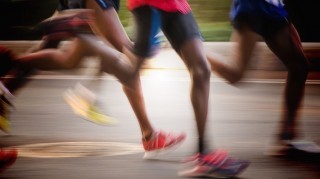
Compression apparel can help reduce skin-to-clothing friction. Photo: Shutterstock.com
There are many things that can negatively affect your race, but anyone who has ever crossed the finish line hunched over in a delicate crab walk can understand that chafing is one of the most painful and annoying afflictions that can strike you while out on the course.
Dr. Sebastian Gonzales, a member of the sports medical team at the Surf City Marathon and Half Marathon in Huntington Beach, says that the causes of chafing are simple. “Chafing with running typically is just an irritation to the skin from excessive friction,” he says. “This can happen in a variety of places from nipples to thighs—anything is really fair game. It can happen in a place where the skin comes into contact with other skin, where moisture remains or exposed to clothing.” Gonzales says factors like excessive temperatures, sensitive skin and bad clothing choices can exacerbate race-day chafing. “On the topic of overall body composition, if an athlete has excessive skin from recent weight loss, excessive fat or even excessive muscle skin from muscular development, they can also be more susceptible to chafing,” he adds.
RELATED: Dealing With Injuries That Aren’t Really Injuries
Coach Danny Fisher of Runners Connect says that another chafing culprit behind is your body’s own salt. “When you sweat, you also push out salt,” he says. “Salt grains have a sharp, square structure. As you dehydrate, you continue to push out more salt but not enough water to wash the salts away. That salt then can begin to work like sand paper against your skin.”
Here are five tried-and-true tips to keep yourself safe from the chafe:
1. Get to know your hot spots in advance.
Showing up on on race day hoping that you won’t chafe under your armpits or between your thighs like you have been throughout your training is a big mistake. Fisher suggests a “prehab” routine in order to avoid having to do rehab after the race. Note your problem areas in your running journal and create a plan to treat them with anti-friction lubricant as part of your pre-race preparation routine.
2. Test out solutions in training.
A long training run can also be used as a laboratory for experimenting with anti-chafing remedies. On these runs, select a few different types of lubricants or powders to find out which work best for you. Those who tend to chafe around their nipples should use small Band-Aids to prevent that scary finish-line photo. Also, try out different types of clothes—moisture-wicking fabrics tend to reduce friction better than your most comfortable cotton t-shirt.
3. Wear compression shorts and other snug clothing.
Compression apparel such as shorts or tights can drastically reduce leg-to-leg friction, or problematic instances where too loose clothes bunch up and rub you the wrong way. Fisher also recommends snug undergarments like sportsbras for women. In addition to wearing tighter clothes, be sure to use anti-chafing lubricant to reduce the risk of skin-to-clothing friction.
4. Take early preventative action.
The minute you suspect you’re starting to chafe is the time to do something about it. Gonzales says you shouldn’t feel shy about finding a medical official along the course and asking for Vaseline or other protective supplies. Fisher recommends splashing water on yourself at water stations to rinse away the salt and then applying lubricant on the susceptible area. “Also take your time taking in some electrolytes and fluids,” Fisher suggests.
5. Plan for your chafing recovery.
Gonzales suggests runners rinse any painful parts or irritated areas as soon as possible after the race. “Clean the area with soap and water to remove dirt and debris,” he advises. “Stop the bleeding if there is any via firm pressure and see a doctor if the area does not seem to be improving as normal rashes do within a few days.” He also suggests letting the chafed areas air out. Lastly, learn from the experience. Remember what worked, what didn’t, and log these lessons so that your next race is as friction-free as possible.
RELATED: How Runners Prevent Chafing Issues
The post Running and Chafing: 5 Tips To Ward Off Unwelcome Irritation appeared first on Competitor.com.
Race-Winning Nutrition From The Western States 100
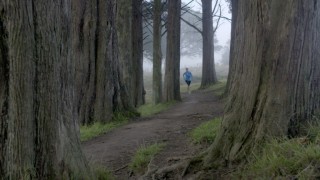
GUtv
Episode two of GU TV features pro cyclist Yuri Hauswald, winner of the 2015 Dirty Kanza 200 gravel-cycling race, interviewing running champ and 2015 Western States 100 race winner Magdalena Lewy-Boulet about the nutrition plans they each used to win their respective races.
We caught up with Magdalena Boulet, winner of the 2015 Western States 100 Endurance Run for additional insights on race-day nutrition. Here’s what she had to say:
Could you describe the breakfast you ate before your successful WS100 day?
Three hours before the race, I ate a small bowl of cooked quinoa with almond butter, salt, and honey and drank a cup of strong coffee. Two hours before the race, I ate two pieces of toast with almond butter and jam. One hour before, I had 16 ounces of hot Lemon Tea GU Brew. Then, five minutes before the start of the race, I had a GU Chocolate Sea Salt Roctane Gel.
Did you test the all-liquid strategy before the race to make sure it would work for you? How? Would you use this strategy again?
My all-liquid fueling strategy at WS100 was very strategic and race specific. The hot conditions at WS100 motivated me to plan my nutritional strategies in order to help me perform as well as possible in a hot environment. I had the opportunity to practice this strategy at the Sean O’Brien 100k and the Canyons 100k races prior to WS. Carbohydrate requirements are increased in the heat, due to a shift in substrate utilization towards carbohydrate oxidation. Proper hydration during hot conditions can enhance performance, avoid thermal stress, maintain plasma volume, and delay fatigue. Overdrinking before, during, and after endurance events may cause sodium depletion and may lead to hyponatremia. The key for me was Roctane Drink, a blend of carbohydrates, electrolytes and amino acids, which I consumed in small but frequent intervals.
In the video, you mentioned consuming “branched-chain amino” acids in your bottle. Why are these important?
Branched chain amino acids are key players in the athlete’s arsenal to maximize performance, recovery, and adaptations to training. When consumed during exercise, BCAAs help reduce central fatigue and decrease soreness. When consumed after both resistance and endurance exercise, they increase muscle protein synthesis rates, decrease degradation, and promote muscle protein accretion and recovery.
The post Race-Winning Nutrition From The Western States 100 appeared first on Competitor.com.
August 31, 2015
Alana Hadley: America’s Next Great Marathoner
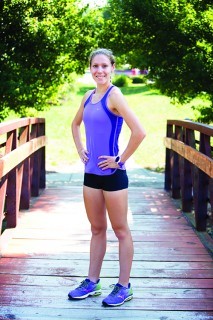
Hadley logs 110-120 miles in her biggest training weeks—a total that has progressed an average of 10 miles a week each year since she started running at age 6. Photo: Gerry Melendez
Heading toward the finish line of the 2013 Indianapolis Monumental Marathon, then 16-year-old Alana Hadley knew she was cutting it close to the U.S. Olympic Trials Marathon standard of 2 hours and 43 minutes.
“When I looked up at the clock on the final straightaway and saw I was going to get the standard, I got really emotional and started bawling,” recalls the now 18-year-old Hadley, who finished fourth that day in 2:41:56. “All your emotions are heightened after a marathon when you are super tired, and I was very overwhelmed with happiness.”
That performance made Hadley, who was a junior in high school at the time, the youngest person to qualify for the Olympic Trials Marathon since Cathy (Schiro) O’Brien did so in 1984, also at age 16. O’Brien, who finished ninth at the ’84 Trials in a still-standing high school record 2:34:24, went on to make two Olympic teams in the marathon—1988 and 1992—a feat Hadley hopes to replicate in a few years.
“While I have achieved a lot at a young age I believe that I still have plenty of areas for me to improve, which I am excited about,” says Hadley, who ran her first road race, a 5K, when she was 6 years old. “I estimate I will be at my physical peak as a marathoner around my late 20s to early 30s.”
Last November, Hadley returned to Indianapolis, winning the race, breaking the course record and lowering her personal best to an impressive 2:38:34—currently the 49th fastest time on USA Track & Field’s qualifier list. A professional since the age of 16—Hadley accepted prize money and the Olympic Trials qualifier bonus at Indianapolis in 2013—she willingly forfeited her ability to compete in high school and collegiate athletics so she could focus on her own long-distance goals.
“I think [longer distances] are the best fit for me physically as well as mentally,” explains Hadley, who is unsponsored. “I started out by running on the roads and in road races, so those will always have a special place in my heart.”
Hadley, who has been coached by her father, Mark, since she started running at age 6, logs 110-120 miles in her biggest training weeks—a total that has progressed an average of 10 miles a week each year. Running twice a day most days, Hadley does five main speed or stamina-focused workouts every two weeks, in addition to core work, plyometrics and form drills.
“Because we have undertaken a balanced and slow growth path to training she has been able to get to a high work capacity level needed for the marathon without serious injury and with very strong bones, joints and ligaments and I don’t see any reason why this will change during her career,” explains Mark. “Ultimately I think she has the potential and capabilities to be one of the very best marathon runners in the U.S., and potentially stay there for a good amount of time.”
In August, Hadley moved into her dorm room at the University of North Carolina at Charlotte, where she’ll study exercise science, taking a minimum course load so she can still pursue running at the professional level while concentrating on her studies and still having a social life. Being close to home, she’ll also continue staying involved in her community—she taught Bible study in high school and volunteered at special needs camps in the summer months—while also spending time with her family and serving as a role model for her younger siblings.
“While my main focus is on my running, I also find it important to have other things going on in my life to provide a balance,” explains Hadley, who has donated a portion of her prize winnings to Autism charities. “If I only have one thing going on I tend to overthink it sometimes and stress myself out, so having other things to maintain a balance in my life is important.”
The post Alana Hadley: America’s Next Great Marathoner appeared first on Competitor.com.
The Lowdown on Little Running Shoes
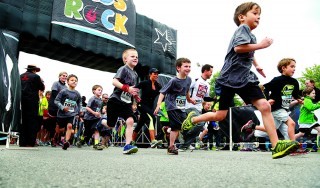
Photo: Rock 'n' Roll Marathon Series
More and more footwear companies are releasing shoes for kids based off the adult versions of the same model. Is this a marketing ploy, appealing to running parents who think it’s cute to have a “Mini-Me?” Or are these shoes worth the sticker price?
It’s the latter. While materials are often durable to withstand the rigors of being a kid, mini versions of adult shoes assure you that your children aren’t wrecking their feet when they run.
Shoes for kids up to age 5 should be completely flexible (think sock-like) to allow constant growth and strengthening. “But as kids enter school and begin sports and higher-level activities, there’s a necessity for protection,” says Eric Rohr, Brooks Running’s senior biomechanical engineer.
However, that doesn’t mean kids should be put in combat boots, or even stability shoes. Kids’ feet grow and change in length, width, girth and arch shape up until roughly the age of 13.
“Patterns, materials and closures need to be carefully selected in an effort to support a child’s growing and changing foot,” says Scarlett Batchelor, New Balance Kids’ Business Unit Manager.
And don’t put your kid on the treadmill at the running shop just yet. “Unless a kid has any pain or problems, or is logging extreme miles,” says Rohr, “a gait analysis is probably unnecessary until their teenage years.”
Bottom line: Having kids—especially ones who run in an after-school program or races of any kind—in shoes made for running can help mitigate pain and potential problems. It can also help with their running, as well as make them feel fast like Mom and Dad.
RELATED: New Fall 2015 Kids Running Shoes
The post The Lowdown on Little Running Shoes appeared first on Competitor.com.
New Fall 2015 Kids Running Shoes

Kids … they’ll run themselves ragged on the playground, chase friends around the park, and occasionally run the kids’ race at one of your events. Now their shoes benefit from technologies found in grown-up running shoes: lightweight cushioning, flexible outsoles and a bit of support where they need it. Our fleet of mini testers put these six new models through their own wild paces just in time for back-to-school shopping.
RELATED: Get Kids Running Early
Photo Gallery
1 of {count}
Back to Start
View Larger Image
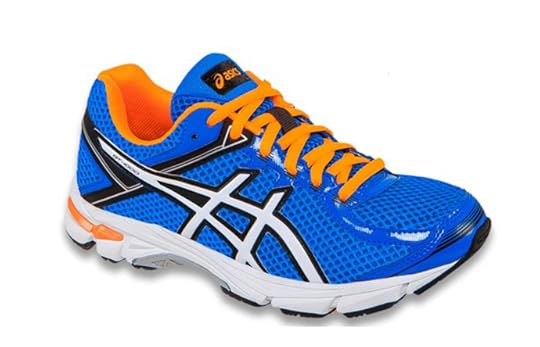
ASICS GT-1000 4 GS, $65
Like the adult version of this shoe, the kids’ GT-1000 gets rear-foot gel and a dual-density midsole. Parents appreciated the supportive heel cup and how the Velcro band on the smaller sizes allowed young ones to be fully self-sufficient. (There’s even a whale head on one foot and tail on the other to help kids’ figure out the correct feet.) Kids, especially little girls, raved about the colors. “They look pretty good on me,” said one. And while another noted that they made her feel “bouncy,” she added, “My favorite thing about them is everything.” Her parent added that these shoes won out over her daughter’s My Little Pony flip-flops and sparkly princess Mary Janes. Available in sizes 1-7.
View Larger Image

Brooks PureFlow 4 Grade Boys Ki, $70
Following the design of the adult PureFlow—a minimalist shoe in structure but with ample cushioning—kids loved the comfort of this shoe. “I like when you step, there is padding on the bottom,” said one. Kids also noticed the room for toe wiggling in the forefoot, and appreciated the breathability provided by “the vents.” Parents liked how the forefoot room and flexibility seemed great for constantly growing and expanding feet, but worried that the combination of ample cushioning and minimally structured upper might be “great for moving forward, but maybe not for P.E.” Toddler sizes have a Velcro closure.
View Larger Image

New Balance Vazee Rush, $45-$65
This shoe is built like an adult’s pair you’d wear for speedwork—lightweight, flexible and with responsive cushioning. Kids took notice: “The toes bend a lot, and that can make you go faster,” said one, who also noted and liked that the Vazee Rush’s weren’t as bendy as his Nike Frees. “There’s a lot of grip on the bottom,” noted another. All testers liked the comfort of this shoe, particularly the padded tongue, but parents lamented the white midsole quickly dirtying up. Parents did, however, appreciate the varying foam densities providing light support without stiffness for growing feet. Available in grade school, pre-school and infant sizing.
View Larger Image

Reebok ZPump Fusion, $90
Parents of testers tended to see the Pump function of this shoe—an air-pumping button that inflates the upper to create a custom fit—as gimmicky. But the kids’ reaction? Testers from ages 6 to 9 found it “kind of fun,” and said, “I loved pumping it!” (One kid tried to pump it enough to see if it would explode. He had no luck.) Kids felt “fast” and “supported” in the ZPump Fusion, once they dialed in the fit—and parents thought they offered enough structure for kids who pronate. Both parties liked the lack of tongue on the upper, which made it easy to get even the widest feet in quickly. Available in sizes 3.5–7.
View Larger Image

Salomon XR Mission J, $55–$60
The XR Mission J is the firmest and least flexible of the lot. One tester noticed that he likes “the way they feel when I bike,” the stiff sole providing support with every pedal stroke. Most kids and parents loved the speed and ease of the one-pull laces, while others felt they couldn’t cinch them down tight enough. (Note: Tucking laces into the “lace garage” on the tongue is imperative to avoiding trip-ups.) The XR Mission J is built as a trail running shoe, with durable tread providing great traction on all surfaces. Available in sizes 13-6.
View Larger Image

Under Armour SpeedForm Fortis, $90
These shoes ranked high with little testers in all-around comfort, likely in part to welded seams taking the place of stitching, and the soft, slightly padded materials of the upper. The heel cup kept feet from slipping around, while letting toes wiggle. “It doesn’t feel like a cast!” said one child. Testers also liked the midsole cushioning, stating, “It’s like jumping on a trampoline.” And they loved how their feet didn't get hot while wearing this shoe. Parents liked how their kids were excited to pull these on day-in and day-out because of the “cool stripes,” but did notice the beginnings of some snagging in the fabric around the toe. Available in sizes 3.5-7

More Galleries
The post New Fall 2015 Kids Running Shoes appeared first on Competitor.com.
An Ultrarunning Trail Fiend of a Dog
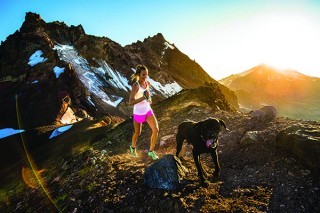
Stephanie Howe Violett, and her dog, Riley, run on a trail near Broken Top Mountain in Bend, Ore. Photo: Tyler Roemer
Stephanie Howe Violett and her husband, Zach, knew they wanted to get a dog they could run with, but they weren’t entirely sure what breed would be best for the long-distance running they do on the trails around Bend, Ore. They’re both ultrarunners who regularly log long hours on the trails—as long as 5 hours or 30 miles at a time.
They did some research and they liked what they had learned about English Pointers. The saw a post on Craigslist from a dog owner who couldn’t handle all of their puppies, so for $20 Stephanie and Zach wound up with an English Pointer/black Labrador mix they named Riley.
“He was the cutest thing ever, so we jumped right in and we got him at 6 weeks,” Stephanie recalls.
They still didn’t know if Riley would become a good ultra-distance running partner, nor did they take him to the trails until he was a year old. After the first couple of shorter runs, they started taking him on almost every run and gradually his endurance increased.
“We don’t do ‘normal people’ runs, so he learned pretty quickly how to get used to the trails,” Stephanie says. “He kind of adopted the ultrarunner lifestyle on the fly. And he loves it. He’s become my favorite training partner.”
When Stephanie or Zach take him out for a run, they’ve always made sure he has plenty of water—either from fresh, flowing streams or from their own hydration packs. But they learned the hard way last winter when Riley bonked a bit after a long run in the snow.
“It was the worst thing ever,” Stephanie says. “He was having a blast romping through the snow but we realized we didn’t give him any food and he just bonked. He started teetering toward the end and Zach had to carry him back to the car. He was so wiped out.”
Lately they’ve made sure to carry plenty of snacks for Riley, including the energy treats known as Glyo-Gen Bones made from maltodextrin, whey and by a local veterinarian.
“I think the key is to train your dog well,” Howe Violett says. “I love dogs, but I don’t love when someone else’s dog runs at me and jumps on me when I’m running. So I think teaching them commands and rewarding them with treats and being consistent is super important. And also keeping in mind that they seem invincible, they will break down at some point. You have to make sure they have food and water.”
The post An Ultrarunning Trail Fiend of a Dog appeared first on Competitor.com.
Photos: Distance Highlights From 2015 IAAF World Championships

The IAAF World Championships in Beijing came to a close on Sunday, as the U.S. racked up 18 total medals (6 gold, 6 silver and 6 bronze) to sit atop the overall leaderboard. Kenya and Jamaica tied for the most golds, with seven a piece.
Here’s a look at the top highlights from the 800 meters through the marathon. All images by PhotoRun.net.
RELATED: Double Gold For Mo Farah—Again
Photo Gallery
1 of {count}
Back to Start
View Larger Image

Genzebe Dibaba Dominates Women's 1500m Final
Running a mind-blowing 1:56 for her final 800 meters, world-record holder Genzebe Dibaba of Ethiopia won the women's 1500 meters in 4:08:09. Shannon Rowbury was the top American finisher in 7th, running 4:12.39. Jenny Simpson, who lost her shoe midway through the race, finished 11th in 4:16.28.
View Larger Image
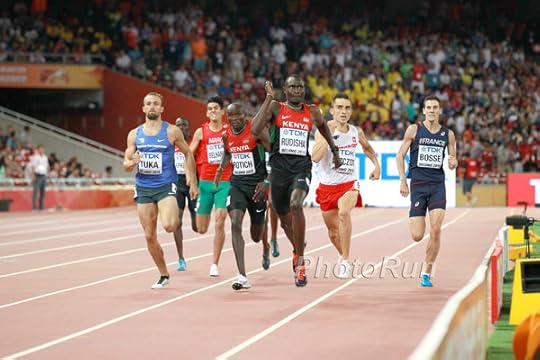
David Rudisha Captures Another 800m World Title
Fast start or slow, it doesn't mater to David Rudisha. After a 54-second opening 400m, the lanky Kenyan sprinted away from the rest of the field to win in 1:45.84. No American men competed in the 800m final for the first time since 2007.
View Larger Image

Hyvin Jepkemoi Comes Out On Top In Women's Steeplechase
Hyvin Jepkemoi came out on top in a crowded flurry to the finish in the women's steeplechase, breaking the tape in 9:19.11. American Emma Coburn was 5th in 9:21.78.
View Larger Image

Marina Arzamasova Wins 800m Gold For Belarus
In the women’s 800m, Marina Arzamasova of Belarus out-kicked Canada’s Melissa Bishop and Kenya’s Eunice Sum for gold, winning her country's first ever medal in the event.
View Larger Image
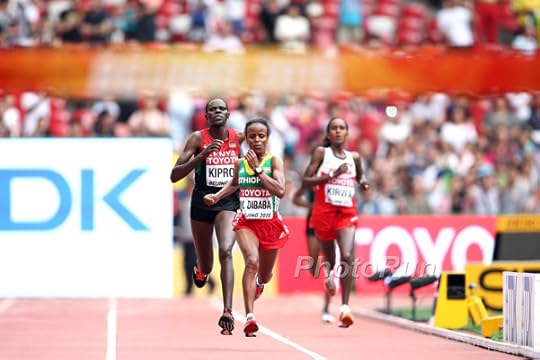
Mare Dibaba Wins Mad Dash To The Finish In Women's Marathon
Ethiopian Mara Dibaba used her superior sprinting speed to get away from Kenyan Helah Kiprop in the final meters to win the women's marathon title in 2:27:35. Kiprop finished a second behind while Eunice Kirwa of Bahrain took bronze in 2:27:39.
View Larger Image
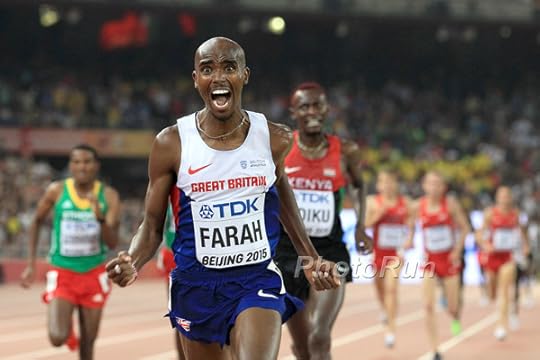
Mo Farah Completes Third Straight Global Double-Double
Mo Farah left no doubt that he is still the best 5,000m/10,000m runner in the world, completing his third straight global 10,000m/5,000m double, winning the shorter race in 13:50.38. Following a slow first 2 miles, Farah ratcheted down the pace over the final 4 laps, closing his last 800m in a reported 1:48 to edge Kenyan Caleb Ndiku for gold. Galen Rupp led a 5-6-7 American finish, beating out teammates Ben True and Ryan Hill to the finish line.
View Larger Image
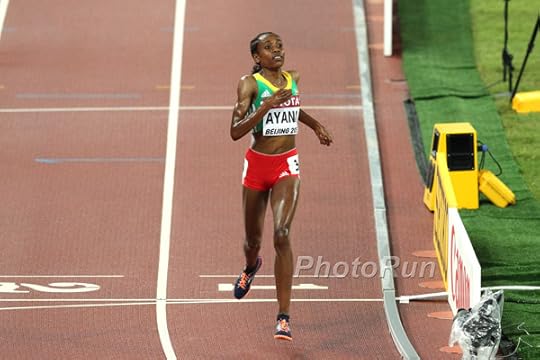
Almaz Ayana Runs Away With Women's 5000m Title
Almaz Ayana ran an eye-popping 8:19 for her final 3000m to run away from countrywoman and heavy favorite Genzebe Dibaba to take the women's 5,000m gold medal in 14:26.83. Dibaba was passed by Senbere Teferi for silver, but held on for bronze to complete an Ethiopian sweep in the event.
View Larger Image
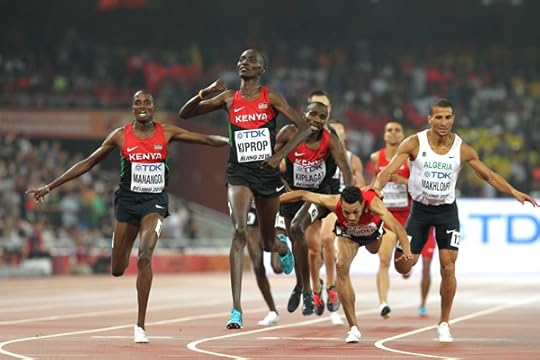
Asbel Kiprop Continues 1,500m Domination
Asbel Kiprop timed his finishing kick perfectly to win the men's 1,500m title in 3:34.40 as the top five finishers all came in under 3:35. Matthew Centrowitz was the top U.S. finisher in 8th, running 3:36.13.
View Larger Image
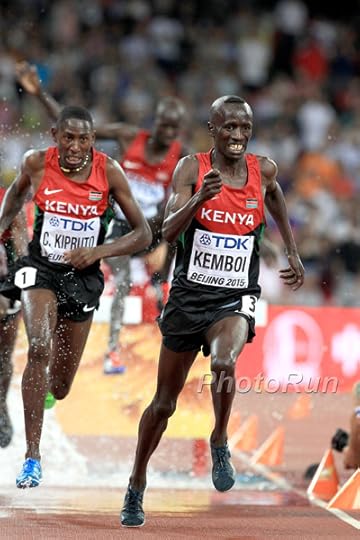
Ezekiel Kemboi Continues Steeplechase Domination
Ezekiel Kemboi of Kenya pulled away from the rest of the field in the final half lap to win his fourth straight world title. Kenya also took spots 2-4 in the race. Americans Dan Huling and Evan Jager were 5th and 6th, respectively.
View Larger Image

Mo Farah Wins a Fast Men's 10,000m
Mo Farah captured his third straight global championship in the 10,000m, using his superior finishing speed to run away from the field and win in 27:01.13. His training partner, Galen Rupp, was 5th in 27:08.91.
View Larger Image
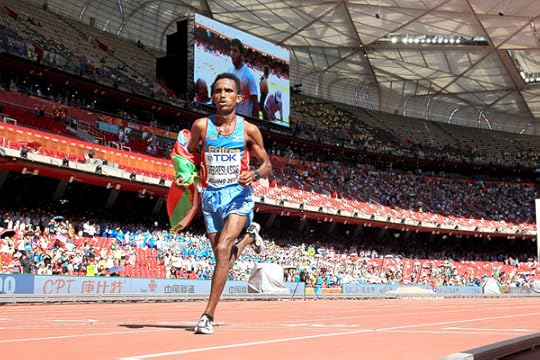
Ghebreslassie Pulls Off Shocker In Men's Marathon
Girmay Ghebreslassie, only 19 years old, captured gold for Eritrea, winning the men's marathon in 2:12:28. Ian Burrell was the top U.S. finisher in 25th, running 2:23:17.
View Larger Image
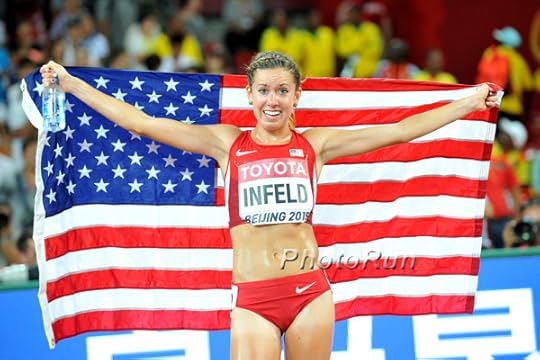
Emily Infeld Sneaks Past Molly Huddle For Bronze In Women's 10,000m
Emily Infeld of the U.S. snuck past an unsuspecting Molly Huddle at the finish line of the women's 10,000m to snag the bronze medal. Vivian Cheruiyot of Kenya out-sprinted a large group of contenders over the last lap to snag gold in 31:41.31.
Related Galleries
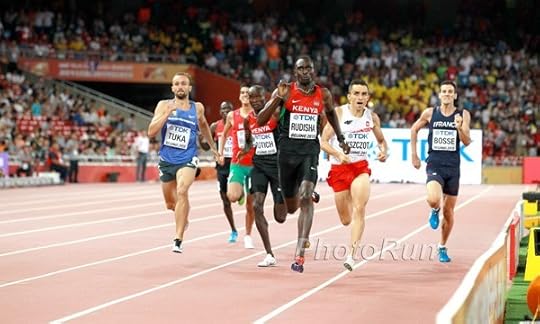
Photos: Men’s 800m Final and Women’s 1,500m Final

Photos: 2015 IAAF World Championships—Men’s Marathon
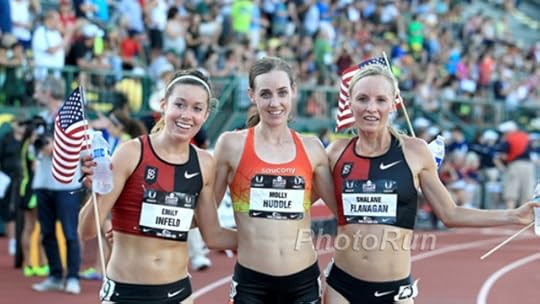
13 Great Storylines at the 2015 World Track & Field Championships
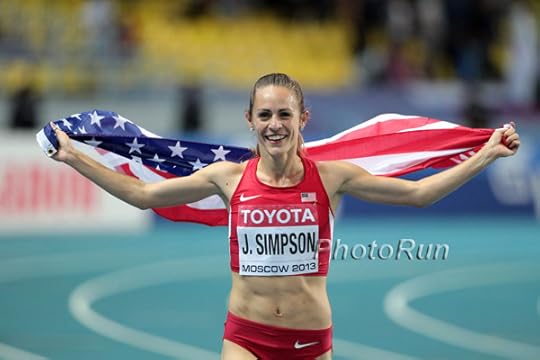
Photos: U.S. Middle Distance & Distance Highlights From World Championships

More Galleries
The post Photos: Distance Highlights From 2015 IAAF World Championships appeared first on Competitor.com.
Americans Run Strong at UTMB, CCC in Chamonix

Zach Miller (left) celebrated his win in the 101K CCC race with some flair on Friday night in Chamonix, while David Laney was stoked to finish third at the 167K UTMB on Saturday afternoon. Photo: Conscious Minds Productions
Since its inception in 2003, the Ultra-Trail du Mont-Blanc (UTMB) has been universally considered one of the most difficult running races on the planet. And with good reason—it sends runners on a grueling 104-mile circumnavigation of the highest mountain range in Western Europe on a relentless course that includes roughly 60,000 feet of vertical gain and descent on the way back to the finish line in Chamonix, France.
With a combination of moderate altitude, long stretches of technical terrain and 10 wickedly steep climbs and descents through parts of France, Italy and Switzerland, it tests runners’ physical, mental and emotional endurance in what is annually one of the most competitive fields of trail running in the world.
“The amount of vertical is pretty crazy,” David Laney, a 26-year-old from Ashland, Ore., admitted after racing in the UTMB for the first time. “Yeah, it’s a pretty brutal course, but it’s an amazing course, too.”
The same can be said to some degree for each of the other four races held in conjunction with the UTMB. Although slightly less competitive and prestigious, the other events, which range from 50K (31 miles) to 300K (186 miles), feature rugged, village-to-village courses with unforgiving changes in elevation. Combined, the festival of races is the biggest trail running event in the world, with more than 7,200 participants and many thousands of race supporters, volunteers and spectators all around the course.
RElATED: Call of the Wild—Ultra-Trail du Mont-Blanc in Chamonix
This year’s 13th annual UTMB—yet another epic battle of attrition, especially because of hot, sunny conditions that peaked with temperatures in the 80s—produced numerous compelling storylines, starting with the dominating wins from French runners Xavier Thévenard and Nathalie Mauclair.
Thévenard joined a select group of runners who have won the race more than once, crossing the finish line Saturday afternoon in Chamonix amid thousands of screaming fans and the blasting of the race’s adopted theme song—“Conquest of Paradise”—after 21 hours and 9 minutes of running. Mauclair, who works full-time as a nurse, received an equally exuberant reception when she crossed the line with a commanding victory in 25:15, becoming the second French woman to win the marquee race.
But one of the biggest stories coming out of Chamonix was the statement Laney and several fellow Americans made by littering the podium with the red, white and blue of USA racing kits in the UTMB and the 101K Courmayeur-Champex-Chamonix (CCC) race.
Laney’s tenacious third-place performance in the UTMB—a smartly executed race in which he started conservatively and moved up the entire way—was one of the very best ever by a U.S. runner in Chamonix. Although he had been as far back as 10th near the halfway point, he caught fellow American Seth Swanson, then in third place, with about 2 miles to go on the final descent into the village.
Swanson, 36, of Missoula, Mont., was the runner-up at this year’s Western States 100 in California on June 27 and had been keeping the pressure on Spain’s Luis Alberto Hernando in the race for second place over the previous 20 miles or so. When Laney arrived from behind, the two chatted briefly about how stoked they were to know two Americans would finish among the top four in Chamonix.
“I asked him how far up Luis was and he said somebody told him 2 minutes, someone else said 5 minutes,” Laney said. “I said, if it’s 2 minutes, lets go for it and if it’s 5 minutes, let’s be smart and just get to the finish line. So we started ripping down that final section because we thought we might catch him.”
Although Swanson—who is sponsored by The North Face—took a tumble on the final descent, he and Laney kicked to the finish like they were in a 10K road race and closed the gap on the hard-charging Spaniard. Hernando finished in 21:57:17, followed by Laney—a member of the Nike Trail Elite team—about two and a half minutes later and Swanson 30 seconds after that.
“Seth Swanson and David Laney ran text book UTMB runs,” said Topher Gaylord, the American runner with the best track record in Chamonix, having finished second (2003), sixth (2005) and 11th (2008) in the UTMB. “There was so much attrition—and American attrition too—but those guys were hanging back, running their race, never having a sense of urgency in the early sections, and that’s key in this race. In the second half, especially the final 25 miles, they were awesome.”
RELATED: UTMB Course Stats via Trail Run Project
Laney, who placed eighth at the Western States 100 in June, turned in an epic performance despite being a bit under the weather all week and suffering from a bloody nose at times during the second half of the race. He said his plan was to run the first 50 miles as easy as possible and then move up from there if he could.
“The leaders started off at a 6-minute mile pace and I dropped back. Even if this was a flat 100-miler, there’s no way I’d be running 6-minute pace,” said Laney, a 2:17 marathoner who will run in the 2016 U.S. Olympic Trials Marathon in Los Angeles next February.
Prior to the race, Laney wrote “M.I.T.” on the back of his left hand, an acronym for “Mind in Trail” and a personal reminder to keep his head in the game.
“It was a great course. The uphills were very hard and some of the downhills were too,” he said. “I had been practicing my technical running all summer to prepare for this. Usually I can run 2 or 3 miles pretty hard downhill, but then my quads make me slow down. But today I was just on … the flow was just so smooth out there.”
In the women’s race, Darcy Piceu, a Hoka One One athlete from Boulder, Colo., turned in another strong performance in Chamonix, finishing fifth in 28:38, while first-timer Stephanie Howe, a North Face-sponsored athlete from Bend, Ore., who finished third at the Western States 100 in June, was eighth in 30:16. Nicole Studer, 33, from Dallas, finished 13th among women in the UTMB in 31:21.
While three U.S. runners have won the UTMB women’s race a total of five times (Krissy Moehl, 2003, 2009; Nikki Kimball 2007; Rory Bosio 2013, 2014), only six American men had finished among the top five prior to this year. Gaylord and Brandon Sybrowsky tied for second in 2003, Mike Wolfe was second in the rain-shortened race of 2010 and Mike Foote was third in the rain-shortened race of 2012.
Prior to Laney and Swanson, the best combined American UTMB effort since the inaugural race (which had just 67 runners) was the 2013 race, in which Tim Olson and Foote placed fourth and fifth respectively (followed by Bosio at seventh overall). Jason Schlarb placed fourth overall last year.
The efforts of Laney, Swenson and Piceu came on the heels of American dominance in the CCC race that covers about two-thirds of the UTMB course from Courmayeur, Italy, to Champex, Switzerland and back to Chamonix. That race has six major climbs and descents and about 20,000 feet of total vertical gain.
In that race, which started on Friday morning, American Zach Miller of Colorado Springs won in 11:53, followed by his Nike Elite Trail teammate Tim Tollefson of Mammoth Lakes, Calif., in second at 12:06. Meanwhile, Magda Lewy Boulet, a Hoka One One-sponsored athlete from Oakland, Calif., a 2008 U.S. Olympic marathoner and the 2015 Western States 100 champion, placed 17th in the CCC race and second among women in 13:17, about 22 minutes behind winner Ruth Croft of New Zealand. Meredith Edwards, an American ski mountaineering racer who splits time living between Wilson, Wyo., and Chamonix, also turned in a strong CCC race, placing 73rd overall and eighth among women in 16:00.
Miller, 26, and Tollfeson, 30, went out with the leaders from the start and were the first to charge over the Grand Col Ferret, the steeply switch-backed 8,169-foot pass between Italy and Switzerland. From there, Miller took a slight lead, only to have Tollefson catch up at about the 31-mile mark in Switzerland. But for the final 25 miles or so—and especially after crossing back into France with about 13 miles to go—Miller was untouchable.
“It’s definitely one of the hardest races I have ever done. In the afternoon it got soooo hot, it was really hard,” Miller said. “At one point, I was thinking, ‘Why do we do this to ourselves?’ I was really kind of miserable. But then once the sun started to go down and it cooled off, my body turned and I felt great. Over the last two climbs, I just put my head down and crushed it.”
Tollefson said he had tried to mimic the course in training in the mountains near Mammoth Lakes, but it was the length of the race (which turned out to be 5 hours longer than the longest run he’d ever done) and the heat that caused him the most trouble. He said he struggled quite a bit with cramping legs in the final 25 miles.
“I was tempted to drop out on the climb out of Champex (at about mile 36),” Tollefson said. “(Martin) passed me and he did it so smoothly that it was kind of demoralizing. My legs were cramping quite a bit and my right calf seized up on me and I fell over into a bush. I was mentally distraught and was ready to be done, but then I saw the fourth-place runner come up from behind me in the distance so I took my time and ate all of the food and drank all of my fluid on the way to the next aid station and I started feeling good by the time I got there. I had held on to third at that point, so I thought, ‘OK, you’re feeling better, you might as well attack it.'”
Tollefson caught Martin on the final climb and then put 10 minutes on him in the final 10 miles of the race to earn his spot on the podium alongside Miller.
In the 50K Orsieres-Champex-Chamonix Race on Thursday, American Dylan Bownman, a North Face-sponsored athlete from Mill Valley, Calif., placed ninth in 5:49, 38 minutes behind winner Marc Pinsach Rubirola of Spain.
The post Americans Run Strong at UTMB, CCC in Chamonix appeared first on Competitor.com.
August 30, 2015
Kiprop Wins Third 1,500m World Title
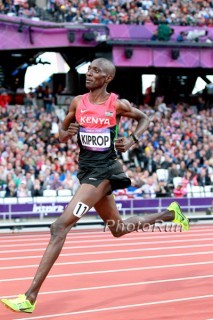
(c) 2015 Race Results Weekly, all rights reserved. Used with permission.
BEIJING — As Kenya’s Asbel Kiprop kicked furiously in the final meters of the men’s 1500m tonight on the last day of the IAAF World Championships in Athletics here, he was running for more than just the gold medal. If he were to reach the finish line first at National Stadium, he would join two of the sports all-time greats, Hicham El Guerrouj of Morocco and Noureddine Morceli of Algeria, as the third man ever to win three or more world 1500m titles (El Guerrouj won four).
It would not be easy. With 200 meters to go in the race, Algeria’s Taoufik Makhloufi, the powerfully-build 2012 Olympic champion, had built up a significant lead with a big move on the back stretch. Kiprop, and his teammates Elijah Manangoi and Silas Kiplagat, were in hot pursuit. There was work to do, but Kiprop tried to remain confident.
“I knew that when it comes to the last 200, 250 meters remember, that’s how Makhloufi won the Olympics in London,” said Kiprop, who finished a disappointing 12th in that race. He continued: when you compare his last 50 meters, he’s not moving. I was a little bit confident that maybe that’s where I could win.”
Indeed, it would come down to just the final 50 meters. Makhloufi was tying up, Kiprop’s teammate Manangoi, and Morocco’s Abdalaati Iguider were also kicking hard, and the tall, lanky Kenyan hit top speed. Makhloufi had been beaten, and his other rivals simply couldn’t match his tempo. He won in 3:34.40 ahead of Manangoi (3:34.63) and Iguider (3:34.67) who practically threw himself over the line. Makhloufi finished fourth.
“I’m really excited; it’s very special to win three times in a row,” said Kiprop with a serious tone. “At the moment, when it comes to World Championships I am together with Noureddine Morceli having won three times. Only El Guerrouj has done more than that, four times.”
Moreover, Kiprop is also among the world’s fastest, ever. His sizzling 3:26.69 personal best at the Herculis meeting in Monaco last month also put him in exclusive company.
“Just one month ago I joined the club of 3:26, with El Guerrouj and Bernard Lagat,” he reminded reporters. “There are only three who have achieved that. Now, I am happy that I am three; only three have won three times or more than three times. I feel like I am making a legacy in middle distance running.”
While both Manangoi and Iguider expressed satisfaction with their performances, the three Americans in the final –Matthew Centrowitz, Leo Manzano and Robby Andrews—were plainly disappointed. Centrowitz, who won the bronze medal at these championships in Daegu in 2011 and the silver in Moscow in 2013, was in excellent position at the bell, right at the front of the pack. But when the hard running began in the final 250 meters, he couldn’t keep up the pace. He faded to finish eighth in 3:36.13. Manzano finished tenth, and Andrews 11th.
“That one hurt,” Centrowitz told a clutch of reporters under National Stadium. “Yeah, that was just hard. Put myself in a good position most of the race. With about 300 to go, was when Makhloufi made a good move again. At that point, I was already all-out and I couldn’t respond. When one guy goes buy you, then another and another, it’s a little demoralizing.”
Also disappointed was New Zealand’s Nick Willis, who won silver on this track at the 2008 Olympics. He would finish sixth tonight.
“My hopes were pretty high when I was second at the bell,” said the former University of Michigan star. “He’s obviously the man to beat at the moment.”
The woman to beat at the moment, Ethiopia’s Genzebe Dibaba, was in fact beaten tonight. In a spectacular championships record performance, Almaz Ayana ran away from the 1500m gold medalist in the 5000m, clocking a sizzling 14:26.83. Dibaba, who ran in second place most of the race, could not defend her position in the final drive to the line, outsprinted by her teammate Senbere Teferi, 14:44.07 to 14:44.14.
“This is the prize for me,” said Ayana. “I won the gold medal and I got the championships record.”
Amazingly, Ayana might have gotten close to the world record (14:11.15) had the first five full laps not been run in the 72 to 73 second range as they were. So fast were her final kilometers, that she ran the last 3000 meters in 8:19.91, faster than every non-Chinese mark on the 3000m all-time list.
But Ayana said she wasn’t thinking about the clock, only winning.
“I was heading to get the gold, purely,” she said.
The four Kenyans in the final –Viola Kibiwot, Mercy Cherono, Janet Kisa and Irene Cheptai– finished fourth through seventh, respectively.
The Ethiopia sweep of the medals was the first in this discipline since the Ethiopian team did it in Helsinki in 2005 when Tirunesh Dibaba, Meseret Defar and Ejagayou Dibaba finished 1-2-3.
The post Kiprop Wins Third 1,500m World Title appeared first on Competitor.com.
Dibaba Wins Marathon Gold For Ethiopia
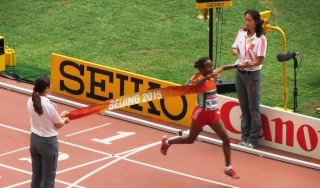
Mare Dibaba breaks the tape in National Stadium, winning by one second over Kenyan Helah Kiprop. Photo: David Monti | Race Results Weekly
(c) 2015 Race Results Weekly, all rights reserved. Used with permission.
BEIJING — On the final day of the 15th IAAF World Championships in Athletics at National Stadium, the longest race on the women’s program, the marathon, was decided by just one second.
Ethiopia’s Mare Dibaba—no relation to multiple gold medalist Tirunesh Dibaba or her younger sister Genzebe—won the first-ever marathon gold medal by an Ethiopian woman at these championships. Not even five feet tall, the tiny Dibaba stormed into the stadium with her taller Kenyan rival, Helah Kiprop, outkicking her for gold, 2:27:35 to 2:27:36 in the closest finish ever in the history of these championships. Bronze went to Eunice Kirwa, a Kenyan-born athlete who switched her allegiance to Bahrain in 2010.
“I had a very strong strategy to (out) kick everybody,” Dibaba told the media after the race, adding that she used the four Kenyans in the race to set the pace for her. “My plan was to follow them, head-by-head.”
Dibaba, whose coach Haji Adillo told Race Results Weekly two days ago that she was in the best shape of her life, took a patient approach to today’s contest. Running with her Ethiopian teammates, Tigist Tufa and Tirfi Tsegaye, she was content to cruise along at the gentle early pace, set mostly by the Japanese team of Mai Ito, Risa Shigetomo and Sairi Maeda. The entire Kenyan team, led by defending champion Edna Kiplagat and last year’s TCS New York City Marathon runner-up Jemima Sumgong, was also in the lead pack which which cruised through half-way in a modest 1:15:16. The soaking humidity made running any faster difficult.
“The pace was good,” commented the bronze medalist Kirwa.
Slightly behind the 16-strong lead pack, America’s Serena Burla was working her way up with China’s Ding Changqin and Wang Xueqin. Burla, a cancer survivor, said she was just trying to be competitive and put herself in position to contend.
“I just really wanted to put on the USA uniform, execute, and put myself in it,” Burla said after the race.
By 30K (1:46:50), the Japanese team was struggling to keep up. Like they had done in the 5000m and 10,000m track races at these championships, they set the pace early, but then faded when the faster running started. The five kilometers between 30 and 40K were the fastest so far in the race (17:15), putting the Japanese (and American Burla who would finish tenth) out of contention. That segment was fast enough to dwindle the pack to just six: Dibaba, Sumgong, Kirwa, Kiprop, Kiplagat and Tufa.
Just three minutes later, Tufa was dropped (she would finish sixth). Kiplagat, who is typically comfortable running at the back of the pack, was staying in contact, but soon she too started to fade.
“I was not expecting it,” Kiplagat said of falling off the pace and eventually finishing fifth. “I tried to run my own race. I tried to put in my tactics, but it didn’t work. My legs were too tight, and my body did not react as I expected.”
The 5K segment through the 40K mark was covered in a swift 16:34, easily the fastest of the race. The four women left—Dibaba, Kiprop Kirwa, and Sumgong—were all still in contention as National Stadium came into view.
“When we were at 40 kilometers it was a bit tricky,” observed Kiprop, who was competing in her first World Championships. “Everybody was there. Everybody was strong.”
All four women entered the tunnel to the stadium at about the same time, but Sumgong was lagging. Into the arena, Dibaba and Kiprop emerged from behind the electronic sign at the top of the homestretch together. Like the men last weekend, they only had 110 meters to run in the stadium: a straight drag race for the tape.
“When I saw the Ethiopian athlete pushing, then I tried to push,” Kiprop told reporters. “I didn’t expect, but I tried my best.”
Down the homestretch, Dibaba showed remarkable speed for a marathoner, her short legs turning over furiously as she headed for the tape. She said she was ready for any kind of finish.
“When we were coming, the two of us on the track, I wanted to use all my energy to the final line,” Dibaba told Race Results Weekly with Coach Adillo translating. “I know I have a fast kick at the end. I don’t worry about anything.”
Dibaba’s medal lifted the Ethiopian team to the sixth position on the medal table with two golds and a total of five medals. Genzebe Dibaba has a chance to win another gold tonight when she races in the 5000m. Ethiopia won 10 medals at the last IAAF World Championships and was the sixth-ranked team.
Also, with her victory, Dibaba is now on top of the Abbott World Marathon Majors leaderboard for Series IX with 41 points. Kiprop is second with 32 points. The series concludes at the Tokyo Marathon next February when the top male and female point-earners will be awarded a $500,000 grand prize. Today’s victory was worth $60,000 in prize money, but certainly nearly as much from her corporate sponsor, Nike.
In all, 52 women finished today’s race and another 13 dropped out.
The post Dibaba Wins Marathon Gold For Ethiopia appeared first on Competitor.com.
Ryan Hall's Blog
- Ryan Hall's profile
- 21 followers



